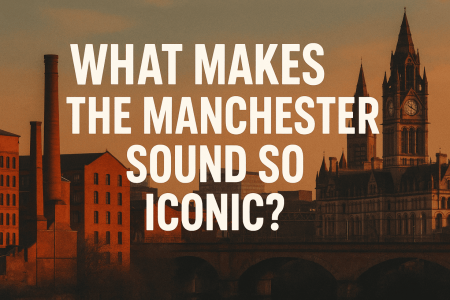Manchester has always been more than just a city. It’s a sound, a scene, and a spirit that changed music forever. From gloomy post-punk to euphoric rave beats, its influence runs deep across decades and genres. Bands from this northern city didn’t just make records. They made movements.
Whether it was the raw edge of Joy Division or the swagger of Oasis, Manchester gave the world music that felt real, urgent, and full of attitude. The city’s artists have always had a way of capturing life in sharp, emotional detail.
But what exactly makes the Manchester sound so iconic? And why does it still matter today?
The Roots: Industrial Grit and Working-Class Soul
Manchester’s sound was born in the shadow of mills and factories. As the city shifted from an industrial powerhouse to a post-industrial sprawl, its music began to reflect the tension, frustration, and resilience of working-class life. The streets were grey, the skies often darker, but out of that came something raw and honest.
In the late 1970s, bands like Buzzcocks brought a fast, urgent punk sound straight from the heart of the city. Then came Joy Division, whose cold, echoing tones mirrored the feeling of isolation many felt in a changing world. Their music wasn’t polished or perfect. It was real. It carried the weight of a city that knew struggle but never stopped pushing forward.
The Sound Defined: What Is the Manchester Sound?
The Manchester sound is hard to pin down because it doesn’t belong to one genre. It’s a mix of styles that somehow fits together. Think sharp guitar lines soaked in reverb, steady drum grooves that pull you in, and basslines that feel like they could carry a song on their own. Add in synths, attitude, and a touch of melancholy, and you start to get the picture.
It’s music that walks the line between emotional and cool. From the raw edge of post-punk to the hypnotic pull of acid house, Manchester artists never stuck to one lane. They took punk’s energy, post-punk’s mood, and rave’s rhythm, then folded it into indie rock with a dancefloor twist.
The Factory Records Era
You can’t talk about the Manchester sound without talking about Factory Records. Launched in 1978 by Tony Wilson and a group of like-minded creatives, it was more than a record label. It was an idea. Factory wasn’t built to chase trends. It existed to give artists freedom and to turn music into something bigger than just sound.
Joy Division was the first to put Factory on the map. Their bleak beauty set the tone, and when they evolved into New Order, the sound shifted toward electronic beats without losing its emotional weight. A Certain Ratio brought in funk and groove, pushing the label even further from the mainstream.
At the center of it all stood The Haçienda, a nightclub part-owned by Factory and New Order. It became the beating heart of Manchester’s music scene. With its concrete walls and forward-thinking playlist, it wasn’t just a venue. It was a cultural shift. It gave space to DJs, dancers, and a new generation of artists who blurred the line between rock and rave.
Madchester & The Cultural Explosion
By the late ’80s, Manchester wasn’t just making music—it was setting the pace for a full-blown cultural shift. Bands like Happy Mondays, The Stone Roses, and Inspiral Carpets fused jangly guitars with danceable beats, creating a new sound that felt loose, loud, and alive. This was the birth of Madchester.
At its core, Madchester was a collision of acid house and indie rock. It had the groove of club culture and the grit of live bands. The music was funky, psychedelic, and unpredictable. It wasn’t polished, but that was the point. It captured a mood more than a formula.
Ecstasy culture played a major role. The Haçienda became a central hub, filled with flashing lights, baggy clothes, and sweat-soaked nights that stretched into morning. The dancefloor was just as important as the stage.
The Aftershock: Britpop and Beyond
When Britpop exploded in the mid-’90s, Manchester was right at the heart of it. Oasis didn’t just carry the torch—they lit a fire. Their sound, attitude, and working-class swagger were straight from the city’s DNA. Loud, proud, and unfiltered, they took what came before and made it stadium-sized.
But the ripple effect didn’t stop there. The blueprint laid by Manchester’s earlier scenes kept showing up in new forms. You can hear it in the polished yet moody pop of The 1975, who mix guitar hooks with synth sheen and emotional depth. Even grime, with its raw energy and defiant tone, shares that same spirit of pushing back against the mainstream.
Why It Endures
The Manchester sound lasts because it was never just about trends. It spoke to something deeper—real emotion, real experience, and a sense of place you could feel in every beat. Whether it was the icy introspection of Joy Division or the loose-limbed chaos of Happy Mondays, the music always had heart.
There’s a swagger to it too. Not in a manufactured way, but in how the artists carried themselves. Confident, but never fake. That self-belief gave the music weight, even when it was experimental or rough around the edges.
What truly sets it apart, though, is its ability to evolve. Manchester’s sound has shifted across decades—absorbing punk, rave, indie, pop—without ever losing its core identity. That mix of honesty, groove, and grit continues to inspire.
